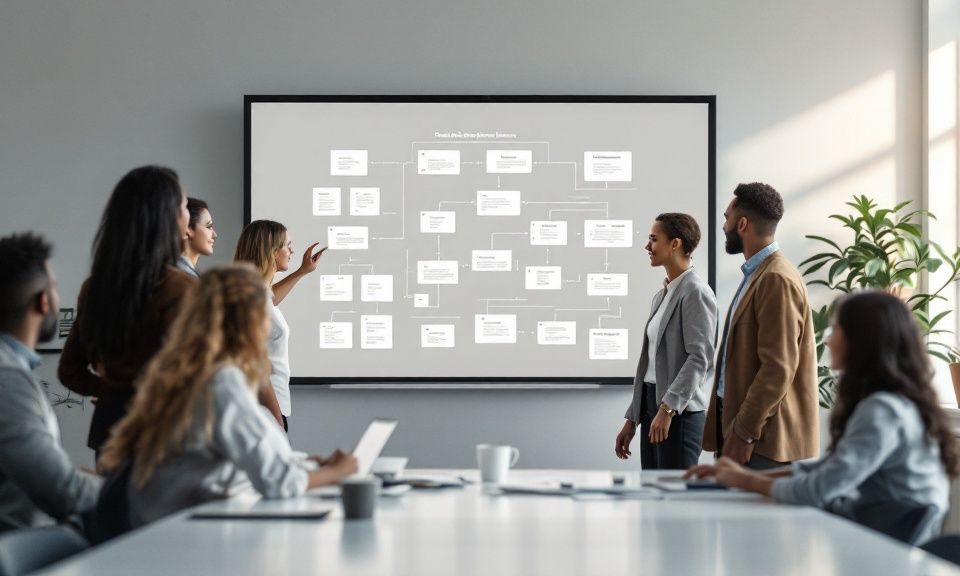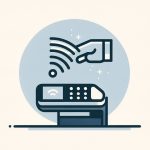
Ditch the Card Machine: How Xero Tap to Pay Turns Your Phone into a Payment Terminal
August 29, 2025
Why Cash Buffers Matter More Than Profit for Your Business Survival
August 31, 2025The Hidden ROI of Client Retention vs. Acquisition
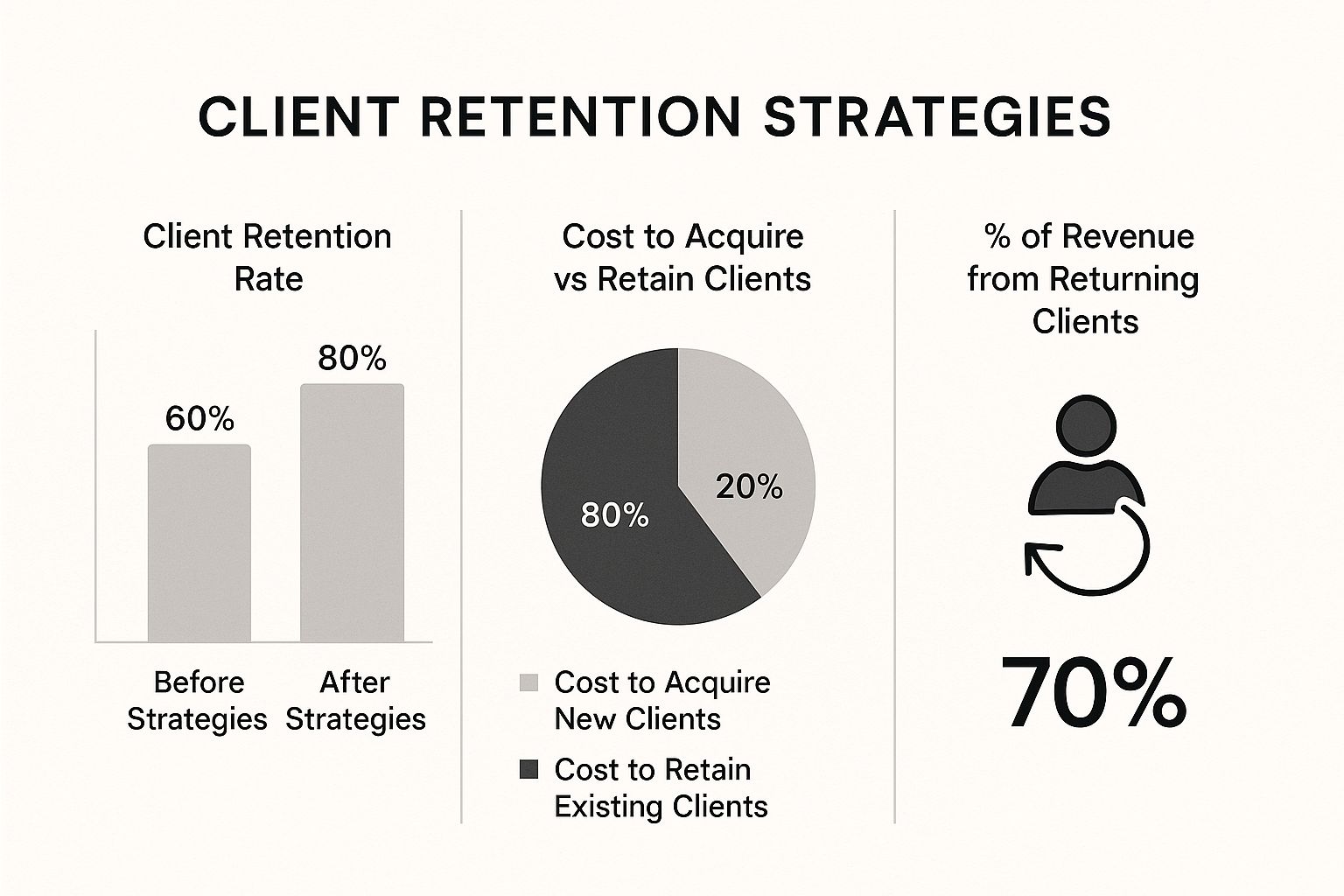
Many businesses prioritize attracting new clients, often overlooking the value of their existing customer base. Constantly pursuing new leads can be expensive and inefficient. Think of it like trying to fill a leaky bucket. Instead, improving client retention is key for sustainable growth.
Acquiring new customers can cost five times more than retaining current ones. A Harvard Business Review study even showed that increasing customer retention by just 5% can increase profits by 25% to 95%. This demonstrates the substantial potential return on investment (ROI) of a solid client retention strategy.
Why Retention Trumps Acquisition
Focusing on client retention offers several advantages. Retained clients are more likely to become brand advocates, providing positive word-of-mouth referrals. This organic growth strengthens your market position and reduces reliance on costly marketing.
Long-term clients tend to have a higher average order value. They’re also more open to upselling and cross-selling, meaning that prioritizing retention not only cuts costs but also boosts revenue.
Visualizing the Impact: The Retention ROI Chart
The following data chart visually compares the potential ROI of client retention against acquisition. The chart breaks down the cost of acquiring a new client versus retaining an existing one, and shows the potential revenue generated by each over time.
(Infographic will be inserted here)
This data chart uses bars to represent key metrics:
- Bar 1 (Acquisition Cost): Shows the average cost of acquiring a new client (e.g., marketing, sales).
- Bar 2 (Retention Cost): Shows the average cost of retaining an existing client (e.g., customer service, loyalty programs).
- Bar 3 (Acquisition Revenue): Shows the average revenue from a new client in their first year.
- Bar 4 (Retention Revenue): Shows the average revenue from a retained client over several years.
The chart highlights a significant trend: while acquisition costs are initially high, the long-term revenue from retained clients significantly surpasses both acquisition and retention costs. This emphasizes the importance of nurturing existing customer relationships to maximize ROI. Investing in client retention strategies unlocks significant growth potential and builds a sustainable, profitable future.
To further illustrate the cost differences, let’s examine a comparison table.
The table below, “Acquisition vs. Retention: Cost Comparison,” compares the costs and benefits of customer acquisition strategies versus customer retention strategies.
| Metric | Customer Acquisition | Customer Retention | Difference |
|---|---|---|---|
| Cost | High | Low | Significant |
| ROI | Lower initially, potentially higher long-term | Higher over time | Varies based on strategy |
| Customer Lifetime Value | Potentially high if retention is successful | High | Dependent on retention efforts |
| Word-of-Mouth Referrals | Low initially | High | Significant increase with retention |
This table clearly demonstrates the financial benefits of prioritizing customer retention over acquisition. While acquiring new customers requires significant upfront investment, nurturing existing relationships leads to higher long-term profitability through increased customer lifetime value and positive word-of-mouth marketing. This reinforces the idea that focusing on retention is a crucial strategy for long-term success.
Measuring What Matters: Retention Metrics That Drive Growth

Understanding which metrics truly affect your bottom line is the first step toward effective client retention. This means looking beyond superficial numbers and focusing on the data that predicts long-term success. Simply measuring website visits, for instance, doesn’t tell you if those visitors convert into loyal clients.
Instead, we need to examine the metrics that reveal the true strength of our client relationships.
Key Retention Metrics To Track
Several key metrics offer valuable insights into client retention. These include customer retention rate, churn rate, customer lifetime value (CLTV), and repeat customer rate.
Tracking these metrics helps businesses understand their client retention performance and identify areas for improvement.
- Customer Retention Rate: This measures the percentage of clients who remain with your business over a specific period. A high retention rate suggests strong client relationships.
- Churn Rate: This is the opposite of retention rate. It shows the percentage of clients lost during a specific period. A high churn rate often signals problems with the client experience.
- Customer Lifetime Value (CLTV): This essential metric predicts the total revenue you can expect from a client over the entire duration of their relationship with your business. Understanding CLTV allows you to effectively prioritize high-value clients.
- Repeat Customer Rate: This measures the percentage of clients who have made multiple purchases or used your services more than once. A high repeat customer rate indicates strong customer loyalty.
Tracking these metrics requires a system for collecting and analyzing client data. Thankfully, many tools and software options, like HubSpot, simplify this process.
The Communication Blueprint for Unbreakable Client Bonds
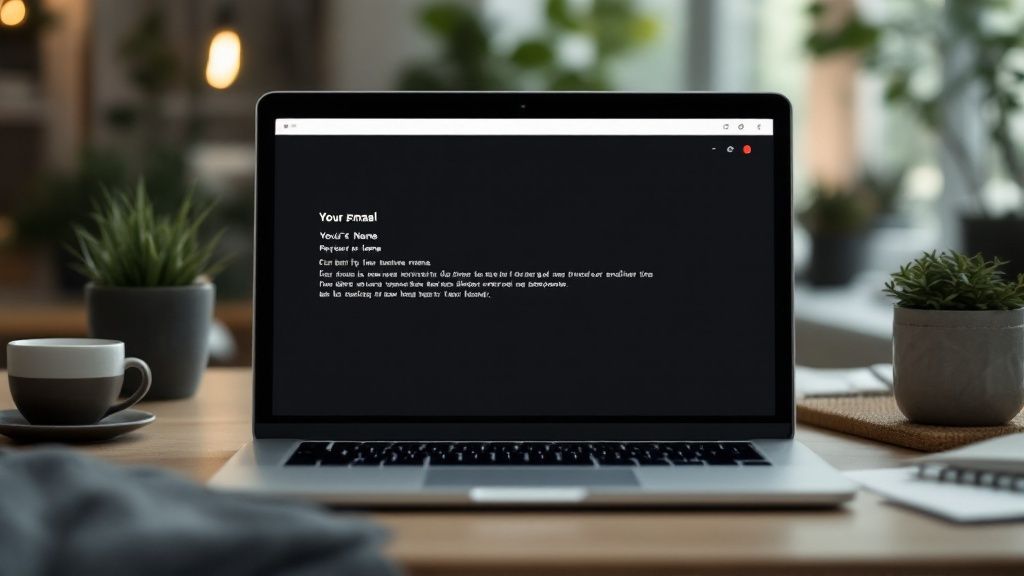
Effective communication is key to improving client retention. It’s not just about the frequency, but the quality and personalization of every interaction. Building strong client relationships requires a strategic communication framework that builds trust and consistently demonstrates value.
Personalized Communication: Speaking Directly to Your Client
Just like a tailored suit fits better than one off the rack, personalized communication is more effective. Understanding your client segments is crucial. This allows you to create messages that address their specific needs and pain points. This makes clients feel understood and valued.
For example, a small business owner might appreciate concise, actionable advice. A larger corporation, on the other hand, may need more in-depth analysis and reporting. This tailored approach strengthens client relationships and increases client retention.
Finding the Right Communication Cadence: Striking a Balance
How often you communicate matters. Too much can be overwhelming, and too little can make clients feel forgotten. The ideal frequency depends on the client’s needs and the nature of your services. Some clients might prefer weekly updates, while others only need monthly check-ins.
Establishing clear expectations upfront and regularly reviewing the communication plan helps maintain a healthy balance. This ensures your communication is effective and strengthens, rather than strains, the relationship.
Handling Difficult Conversations and Gathering Feedback
Open and honest communication is essential, particularly when addressing challenges. Approach difficult conversations with empathy and focus on solutions. Regularly gathering feedback is also critical. It provides valuable insights for continuous improvement.
Requesting feedback shows clients you value their opinions. This can lead to tangible service improvements and foster greater client loyalty.
Leveraging Technology to Enhance Human Connection
Technology can be a powerful tool to enhance, not replace, human connection. Automated emails and chatbots can streamline communication, but they should complement, not substitute, personal interactions.
Consider using a CRM system to track client interactions, personalize communication, and provide a seamless experience. This blended approach uses technology efficiently while retaining the personal touch that builds strong client relationships.
To illustrate a structured approach, let’s consider a sample communication framework. The table below details communication strategies at various stages of the client relationship.
Client Communication Framework: A structured approach to client communications at different relationship stages
| Relationship Stage | Communication Goals | Recommended Channels | Key Messages | Frequency |
|---|---|---|---|---|
| Onboarding | Welcome, set expectations, provide initial resources | Email, phone call, welcome packet | Introduction, next steps, contact information | High (weekly) |
| Ongoing | Provide updates, offer support, share valuable insights | Email, newsletters, blog posts, social media | Progress reports, industry news, helpful tips | Moderate (bi-weekly/monthly) |
| Post-Project/Service | Request feedback, explore future opportunities | Email, surveys, phone calls | Thank you, feedback request, future project discussion | Moderate (monthly/quarterly) |
This framework ensures consistent and impactful communication throughout the client lifecycle, significantly contributing to long-term retention. Building strong client relationships requires continuous effort and a genuine commitment to providing exceptional value.
Crafting Client Experiences That Make Switching Unthinkable
Client retention isn’t just about keeping clients happy. It’s about crafting experiences so valuable they can’t imagine going anywhere else. This means understanding how clients make decisions and building real connections that go beyond simple transactions. Think of it like the difference between a casual acquaintance and a close friend. You’re much more likely to stick with a friend through challenging times.
Mapping the Client Journey for Retention Opportunities
Mapping your client journey is a critical first step. This means visualizing every interaction a client has with your business, from the initial contact to ongoing service. This map highlights key moments that can either strengthen or weaken loyalty.
For example, a seamless onboarding process creates a positive first impression. But a slow response to a support request can damage trust. By identifying these key moments, you can pinpoint areas for improvement that have the biggest impact. This isn’t about major overhauls; it’s about strategic adjustments that improve the overall experience.
Imagine a restaurant. A single burnt dish can ruin an entire meal, even if everything else is perfect. Likewise, a single negative interaction can harm a client relationship. This underscores the importance of consistent positive experiences.
Personalization That Respects Boundaries: The Key to Meaningful Engagement
Personalization is crucial for building strong connections. But it’s also vital to respect client boundaries. This means understanding their communication preferences and offering relevant information instead of intrusive marketing. It’s about demonstrating care for their individual needs, not just their business.
This personalized approach strengthens the client relationship by fostering trust and open communication. It shows you value them as individuals.
Service Recovery: Turning Churn Moments Into Opportunities
Even with the best intentions, mistakes happen. But service recovery—how you address client issues—can be a powerful retention tool. A well-handled complaint can actually boost loyalty. This shows your commitment to resolving problems and valuing client feedback. Think of it like a broken bone that heals stronger. A successfully resolved issue can strengthen the client relationship.
Responding to complaints with empathy and offering prompt solutions transforms a negative experience into a positive one. This builds client trust and demonstrates your dedication to their success. By addressing client concerns proactively and effectively, you create a stronger foundation for long-term retention.
Beyond Points and Perks: Loyalty Programs That Actually Work
Traditional loyalty programs, with their focus on points and discounts, often miss the mark when it comes to truly improving client retention. These programs can create transactional relationships instead of real emotional connections. This means clients might be loyal to the discounts, not your business. For example, a client might only buy from you when a discount is available, easily switching to a competitor with a better deal.
Rethinking Loyalty: From Transactions to Relationships
Forward-thinking businesses are changing how they think about loyalty programs to build lasting client relationships. They’re moving past simple rewards to create experiences that connect with client values and build real appreciation. This shift requires understanding what really motivates your clients. It’s about connecting your incentives with their needs and desires, not just offering generic discounts.
- Personalize rewards: Instead of general discounts, offer rewards based on individual client preferences. This shows that you value their specific needs and understand their business.
- Create memorable moments: Go beyond simple business transactions. Surprise clients with unexpected things like a handwritten thank you note or early access to new products. These small actions can make a big difference.
- Leverage technology: Use technology like a CRM to manage your loyalty program effectively, but don’t let it replace human connection. Technology should strengthen personal connections, not weaken them. For example, CRM systems can help track client preferences and create more personalized messages, leading to more meaningful conversations.
Designing a Loyalty Program That Drives Retention
Building a successful loyalty program needs a strategic approach. Consider these key elements:
- Align with client values: Understand what your clients really care about. If they value sustainability, partner with environmentally friendly organizations or offer rewards connected to environmental projects.
- Set clear objectives: What are you hoping to achieve with your loyalty program? Increased purchase frequency? Higher average order value? Clearly define your goals to measure how well the program is working.
- Make it easy to participate: A complicated loyalty program can turn clients away. Keep the rules simple and the rewards easy to get.
Measuring Program Effectiveness: Beyond Basic Metrics
Standard metrics like program enrollment and points redemption don’t give you the complete picture. To really measure effectiveness, look at these metrics:
- Client retention rate: Is your program actually increasing the number of clients who continue to do business with you?
- Customer Lifetime Value (CLTV): Are loyal clients spending more over their time with your business?
- Referral rates: Are program members more likely to recommend your business to other people?
Evolving Your Approach: Adapting to Changing Expectations
Client expectations are always changing. Regularly review and update your loyalty program to make sure it stays relevant and engaging. This might mean using new technologies, offering different kinds of rewards, or changing your communication strategy. By understanding client needs and adjusting your methods, you can create a loyalty program that truly improves client retention and contributes to long-term business growth.
Turning Client Feedback Into Your Retention Engine
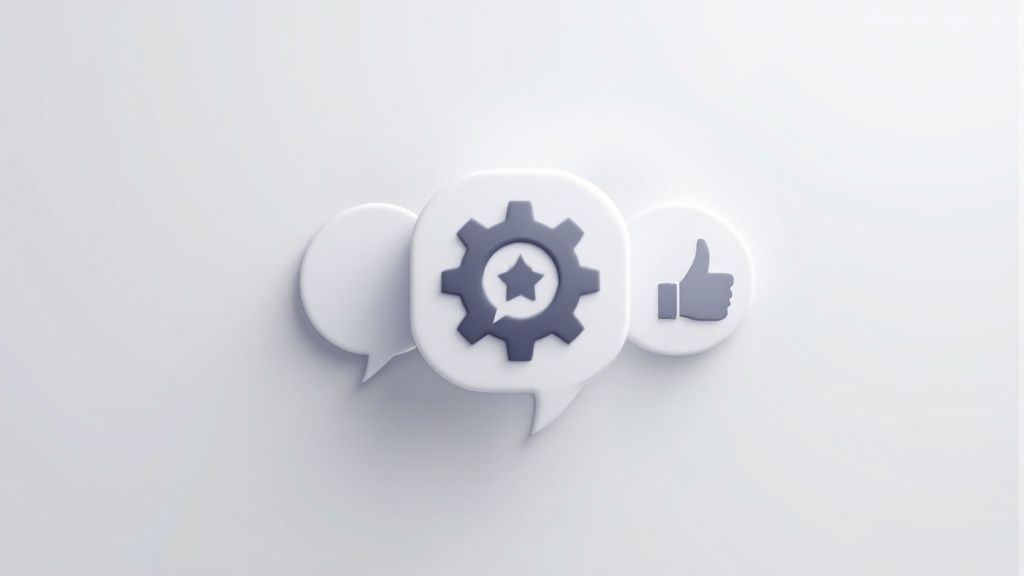
Many businesses collect client feedback, but often don’t use it effectively. Gathering feedback is important, but the real value lies in using it to make meaningful changes. This creates a closed-loop feedback process. Clients see their input directly impacting the services they receive. This shows you care about their success and strengthens their loyalty.
Encouraging Honest Feedback: Creating a Culture of Open Communication
Honest feedback is essential for improvement, even if it’s negative. However, clients might hesitate to share criticisms. Creating a culture of open communication is vital. Clients need to feel comfortable sharing all their opinions. This means actively asking for feedback and reassuring clients that their input is valued.
For example, you could use anonymous feedback forms. Offering incentives for completing surveys also helps. Personal follow-up calls after projects can create a safe space for honest discussions. These methods encourage open feedback and demonstrate a commitment to improving.
Identifying Patterns in Feedback: Unearthing the Underlying Issues
Individual feedback pieces might seem random. But, when analyzed together, they can reveal patterns and systemic issues. You need a system for organizing and analyzing this data. Look for recurring themes and identify the root causes of client concerns. This process can uncover hidden problems that affect client retention.
You could use a simple spreadsheet to categorize feedback. Investing in dedicated feedback management software is also an option. If multiple clients complain about slow response times, it suggests a need to improve internal processes or customer service training. Addressing these underlying problems is key to boosting client retention.
Prioritizing Improvements: Maximizing Retention Impact
Not all improvements are equally important. Some have a bigger impact on client retention than others. Prioritize changes based on their potential to improve client satisfaction and loyalty. Focus on fixing issues that affect many clients, or those impacting key client segments.
For example, if feedback reveals confusion about your invoicing process, simplifying it will likely improve client retention significantly. Addressing a specific need of a high-value client can also strengthen that important relationship.
Communicating Changes Back to Clients: Closing the Loop
After making improvements based on feedback, tell your clients about the changes. This closes the feedback loop and shows them their input was taken seriously. It reinforces their value and builds trust.
You can do this through email updates, newsletters, or blog posts. Highlight the specific changes made based on client feedback. This reinforces the importance of their input and builds stronger client relationships. By actively showing you’re listening and taking action, you’re creating a powerful engine for improving client retention.
Building a Team That Lives and Breathes Client Retention
Your client retention strategy is only as good as the team that puts it into action. This means building a company culture where everyone feels responsible for retention, not just one specific department. When everyone shares this responsibility, each team member becomes empowered to contribute to client success, ultimately strengthening the whole business.
Training Your Team for Retention Success: Empowering Every Interaction
Effective client retention begins with a well-trained team. Give your team the skills and knowledge they need to build strong client relationships at every point of contact. This could include training on communication skills, handling difficult conversations, and understanding client needs.
For example, customer service representatives should be trained to resolve issues quickly and show empathy for client frustrations. Sales teams should prioritize building long-term relationships, not just closing the next deal. Even roles that seem less client-facing, like billing, can have a big impact on retention through providing clear and helpful information. When each team member understands their role in retention, the entire organization works together towards the same goal.
Incentivizing Retention-Focused Behaviors: Rewarding the Right Actions
Incentives can be a powerful tool to motivate your team to focus on client retention. Consider linking bonuses or rewards to retention metrics. This highlights the value of long-term client relationships and encourages behaviors that lead to client success.
This might involve rewarding teams that hit specific retention targets, or acknowledging individual team members whose efforts boost client satisfaction. For instance, rewarding a customer service team for lowering churn rates motivates them to proactively address client concerns. This sets up a positive feedback loop, strengthening both team performance and client loyalty.
Cross-Functional Collaboration: Breaking Down Silos for Client Success
Client retention often requires cooperation between different departments. Creating cross-functional retention initiatives breaks down barriers between teams and encourages a shared understanding of client needs. This shared vision allows for a more comprehensive approach to keeping clients happy.
This could include regular meetings between sales, marketing, and customer service teams to discuss client feedback and find ways to improve. It could also mean incorporating client feedback into discussions about product development. These collaborative efforts ensure that the entire company is in sync with client needs and actively working to enhance their experience.
Knowledge Sharing: Preventing Lost Insights
Effective client retention depends on effective information management. Set up knowledge-sharing systems to prevent important insights about clients from getting lost or staying within individual teams. This makes sure that everyone has the information they need to build and maintain strong client relationships.
This could involve using a shared CRM system to keep track of client interactions. It might also involve establishing regular communication channels to share best practices and important client updates. For example, if a sales team member learns about a specific client need, they can share that information with the product development team to guide future improvements. This transfer of knowledge creates a valuable feedback loop, helping the entire organization learn from every client interaction.
By building a team that prioritizes client retention, you create a solid base for long-term growth and success. Invest in training, offer incentives for the right behaviors, and build systems that support client-focused initiatives. This shift in company culture transforms client retention from a departmental goal into a core company value.
Ready to transform your business and improve client retention? Learn more about how Business Like NZ Ltd can help you achieve financial freedom and build stronger client relationships. Contact us today to discover how our chartered accountancy and business advisory services can help your small to medium-sized business in Auckland.



